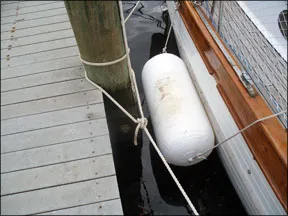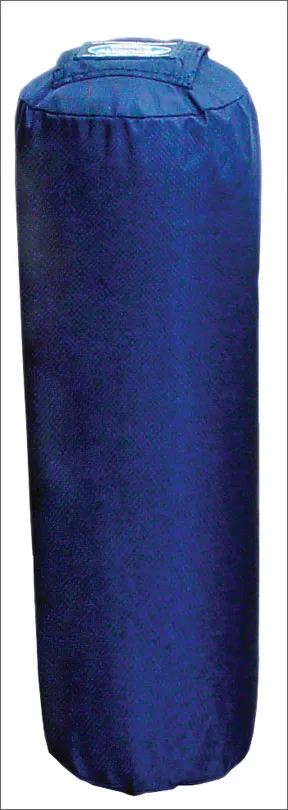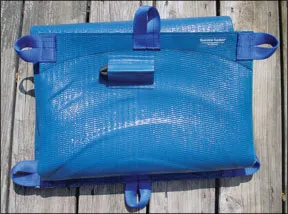
All boats require fenders at some point (docking, rafting, etc.), and the larger the fender needed to create space between boat hull and potential damage, the larger the space the fender will occupy when stored.
A conundrum with traditional fenders is that boat owners are often forced to choose fender size based on available storage space rather than whats required for even moderate conditions, much less extreme situations like storms, rough commercial piers, or poorly maintained docks.
An obvious solution is inflatable fenders, which promise as much impact protection as conventional fenders without the storage headaches. Curious as to whether these claims were just hot air, we put products from three major players in the inflatable fender market to work: StowAway Boat Fenders from DACA Innovations, Aere fenders from Praktek, and Easystow Fenders from Seoladair.
AERE
Praktek of Coral Springs, Fla., has been supplying inflatable fenders to the recreational, mega-yacht, commercial, and military markets for over a decade.
Prakteks Aere Inflatable Fenders use a single bladder made from heavy, high-denier, polyester fabric (like that used in inflatable dinghies) that has built-in UV protection and is heavily PVC coated inside and outside. Each fender is hand-glued with additional seam reinforcement three to seven layers thick (depending on seam location) to assure seam integrity. The company also offers a line of “Extreme Duty” fenders constructed of multiple layers of heavier material.

Like all of the fenders tested, the Aere performed well in the compression test (see How We Tested) but its durable material stood out in the abrasion test.
Line attachment points are welded stainless steel D-rings securely fastened to a layered reinforced material. Inflation and deflation fills are low-profile inflatable dinghy-style valves. Our test fender used a Bravo valve with a spring-loaded stem, or poppet, that is pushed down and locked in the open position for deflation.
Although the inflation valves are high quality (similar to those used on inflatable boats), they proved to be the most complicated to use in this test. One notable feature of the 12×29 fender that we tested is that it will self-inflate about 80 percent with a pull on the D-rings. You can fill it the rest of the way with lung-power. We used a generic foot pump to inflate the Aere.
The Aere comes in a variety of sizes and colors, and offers the most “polished” appearance of the fenders tested, in our opinion. A big plus is the Aeres ability to be owner-
repaired using readily available glue and patches, particularly for those sailing in remote locations.
Bottom Line: The Aere is pricey and its inflation valves are more complex than the others (more parts that can break), but they are high-quality and effective. The Aere is a lightweight, tough fender that has excellent abrasion resistance. We recommend it for those willing to spend a little extra for the polished look.

EASYSTOW
Easystow fenders are made by Seoladair, a small company in LaGrange, Ill., that also manufactures the Boomkicker vang and other products.
Easystow fenders have an inflatable, machine-sealed urethane film bladder inside a thick, polyester-reinforced PVC exterior. The cover for the original “heavy-duty model” we tested is actually extruded as a one-piece tube, providing continuous reinforcement (and greater strength) with no longitudinal seam to catch or split. When deflated, it can be rolled or folded for storage. The top and bottom seams are double-sewn with industrial strength, UV-resistant thread and include six webbing loops for attaching lines.
This thick-skinned fender-at 1/8-inch, its the thickest of the fenders tested-held up well to our abrasion test. There was some scratching to the cover, but the bladder remained fully protected. It also survived the puncture-resistance test well.
Easystow makers claim the fenders can withstand up to 40 psi without ballooning, allowing the fender to be pumped up firmer and support significantly higher loads. The Easy-stow we tested passed the compression test with flying colors.
Easystow uses a rubber tube for inflation and deflation, a simple arrangement that has no threads to cross, O-rings to replace, or caps to lose. (See photo page 33.) The blended rubber tubes are located at the end of the fender and are designed for constant flexing. To seal, the tube is folded in half and inserted under a protective cover, which keeps the tube folded and away from harm.
The tube is smaller than the intake valves of the fenders tested, so the Easy-
stow took the longest to inflate and deflate. But the sheer simplicity of the design makes the processes easy.

We like the rectangular pillow shape the Easystow takes when inflated-it helps prevent rolling when placed against docks or pilings and makes a good replacement for fender boards. This shape (plus the generous number of tie points provided) also allows multiple fenders to be tied together and hung vertically, providing a large, relatively stable grid of protection.
Easystow Fenders are available in heavy-duty and standard-duty models, as well as new model made from heavy-duty, 40-ounce urethane. (We tested the heavy-duty model.) The new urethane fabric is manufactured to meet U.S. military specifications and has advanced UV protection. The fender comes with a lifetime guarantee against manufacturers defects, the best offer of the lot.
Bottom Line: The Easystow is a tough, no-nonsense fender built to take abuse. Its superior warranty and price give it the edge and the Best Choice pick.
StowAway
StowAway Boat Fenders are marketed by DACA Innovations, a Florida-based manufacturer that also distributes Boat Bunkers in-
water mooring stations.
StowAway fenders have an inner vinyl bladder protected by a nylon cover. A recessed, high-volume, one-way valve controls inflation/deflation. To inflate, users pull open the valve flap, open the valve cap, and attach the pump nozzle. To deflate, the one-way valve assembly is unscrewed from the bladder, allowing air to escape. The drawback is that the valve assembly must be detached and it could easily be dropped overboard or lost during use.
The StowAway test fender survived the compression testing intact, however, it didnt fare as well in the durability tests. Testers noted that the inner bladder became deformed during puncture-resistance testing and the outer cover was badly shredded during the abrasion test.

DACA Chief Executive Officer Bruce Nelson explained that StowAway fenders are usually used for occasional use or to have as extras.
“Our fenders are not typically used on a permanent basis, and therefore are typically not subject to extreme abuse,” Nelson said.
Unlike the other fenders tested where users have to tie on lines to hang the fender, the StowAway comes with a sewn-on attachment strap with adjustable buckle on top for easy deployment. A stainless-steel ring on the opposite end allows it to be hung horizontally.
StowAway fenders are available in several sizes and colors. If you buy a kit of four fenders, youll save a few dollars and receive a free hand or foot pump and storage case. Testers liked the carrying case, which makes the pump and fenders readily accessible and easy to stow.
Bottom Line: Testers found the StowAway fenders appropriate for occasional use when rafting up or docking at well-maintained piers. But in our opinion, theyre not durable enough for regular use or in rough mooring situations.
Conclusion
While each of the fenders we tested meets the makers promises of protecting your hull while taking up less storage space than conventional fenders, testers top picks are the Aere and Easystow. For harsh daily use or as part of your storm preparation gear, both would be excellent choices. None of the fenders we tested appeared abrasive enough to scratch your gelcoat, but buying their optional covers would reduce that risk even further.
The Easystow costs less than the Aere fender, and it has the best warranty of the group-this is why it was named Best Choice ahead of the Aere. The more aesthetic Aere, which comes in a wider variety of colors and larger diameters than the Easystow, is Recommended.




































Any chance you will review inflatable fenders again and include the FenderTex product?